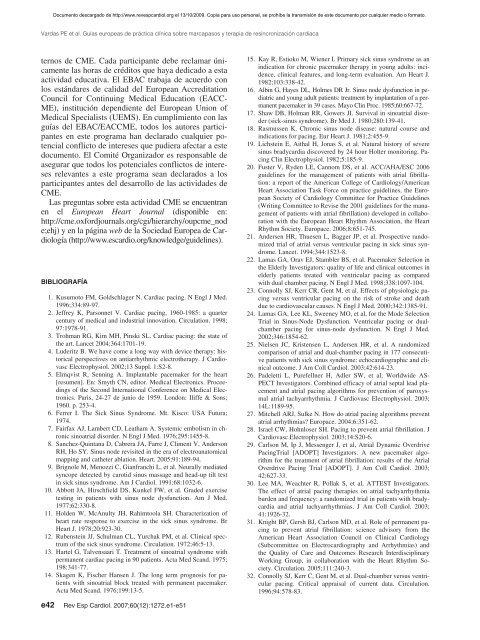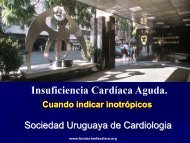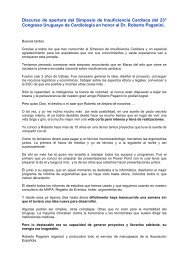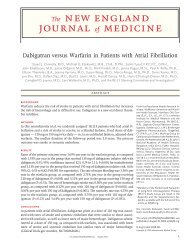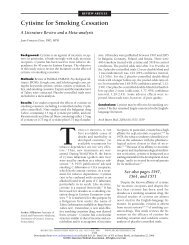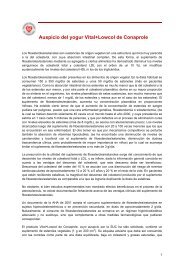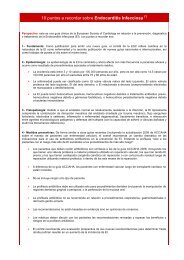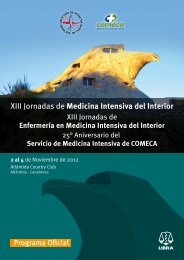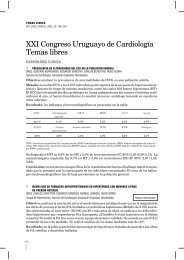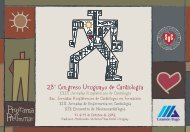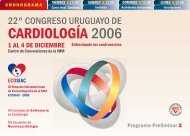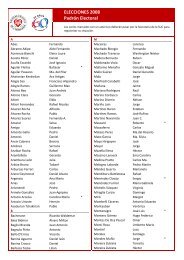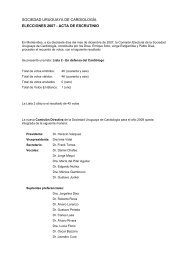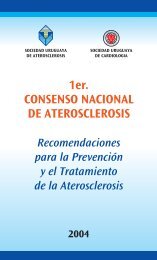vera - Sociedad Uruguaya de CardiologÃa
vera - Sociedad Uruguaya de CardiologÃa
vera - Sociedad Uruguaya de CardiologÃa
Create successful ePaper yourself
Turn your PDF publications into a flip-book with our unique Google optimized e-Paper software.
Documento <strong>de</strong>scargado <strong>de</strong> http://www.revespcardiol.org el 13/10/2009. Copia para uso personal, se prohíbe la transmisión <strong>de</strong> este documento por cualquier medio o formato.<br />
Vardas PE et al. Guías europeas <strong>de</strong> práctica clínica sobre marcapasos y terapia <strong>de</strong> resincronización cardiaca<br />
ternos <strong>de</strong> CME. Cada participante <strong>de</strong>be reclamar únicamente<br />
las horas <strong>de</strong> créditos que haya <strong>de</strong>dicado a esta<br />
actividad educativa. El EBAC trabaja <strong>de</strong> acuerdo con<br />
los estándares <strong>de</strong> calidad <strong>de</strong>l European Accreditation<br />
Council for Continuing Medical Education (EACC-<br />
ME), institución <strong>de</strong>pendiente <strong>de</strong>l European Union of<br />
Medical Specialists (UEMS). En cumplimiento con las<br />
guías <strong>de</strong>l EBAC/EACCME, todos los autores participantes<br />
en este programa han <strong>de</strong>clarado cualquier potencial<br />
conflicto <strong>de</strong> intereses que pudiera afectar a este<br />
documento. El Comité Organizador es responsable <strong>de</strong><br />
asegurar que todos los potenciales conflictos <strong>de</strong> intereses<br />
relevantes a este programa sean <strong>de</strong>clarados a los<br />
participantes antes <strong>de</strong>l <strong>de</strong>sarrollo <strong>de</strong> las activida<strong>de</strong>s <strong>de</strong><br />
CME.<br />
Las preguntas sobre esta actividad CME se encuentran<br />
en el European Heart Journal (disponible en:<br />
http://cme.oxfordjournals.org/cgi/hierarchy/oupcme_nod<br />
e;ehj) y en la página web <strong>de</strong> la <strong>Sociedad</strong> Europea <strong>de</strong> Cardiología<br />
(http://www.escardio.org/knowledge/gui<strong>de</strong>lines).<br />
BIBLIOGRAFÍA<br />
1. Kusumoto FM, Goldschlager N. Cardiac pacing. N Engl J Med.<br />
1996;334:89-97.<br />
2. Jeffrey K, Parsonnet V. Cardiac pacing, 1960-1985: a quarter<br />
century of medical and industrial innovation. Circulation. 1998;<br />
97:1978-91.<br />
3. Trohman RG, Kim MH, Pinski SL. Cardiac pacing: the state of<br />
the art. Lancet 2004;364:1701-19.<br />
4. Lu<strong>de</strong>ritz B. We have come a long way with <strong>de</strong>vice therapy: historical<br />
perspectives on antiarrhythmic electrotherapy. J Cardiovasc<br />
Electrophysiol. 2002;13 Suppl. 1:S2-8.<br />
5. Elmqvist R, Senning A. Implantable pacemaker for the heart<br />
[resumen]. En: Smyth CN, editor. Medical Electronics. Proceedings<br />
of the Second International Conference on Medical Electronics.<br />
Paris, 24-27 <strong>de</strong> junio <strong>de</strong> 1959. London: Iliffe & Sons;<br />
1960. p. 253-4.<br />
6. Ferrer I. The Sick Sinus Syndrome. Mt. Kisco: USA Futura;<br />
1974.<br />
7. Fairfax AJ, Lambert CD, Leatham A. Systemic embolism in chronic<br />
sinoatrial disor<strong>de</strong>r. N Engl J Med. 1976;295:1455-8.<br />
8. Sanchez-Quintana D, Cabrera JA, Farre J, Climent V, An<strong>de</strong>rson<br />
RH, Ho SY. Sinus no<strong>de</strong> revisited in the era of electroanatomical<br />
mapping and catheter ablation. Heart. 2005;91:189-94.<br />
9. Brignole M, Menozzi C, Gianfranchi L, et al. Neurally mediated<br />
syncope <strong>de</strong>tected by carotid sinus massage and head-up tilt test<br />
in sick sinus syndrome. Am J Cardiol. 1991;68:1032-6.<br />
10. Abbott JA, Hirschfield DS, Kunkel FW, et al. Gra<strong>de</strong>d exercise<br />
testing in patients with sinus no<strong>de</strong> dysfunction. Am J Med.<br />
1977;62:330-8.<br />
11. Hol<strong>de</strong>n W, McAnulty JH, Rahimtoola SH. Characterization of<br />
heart rate response to exercise in the sick sinus syndrome. Br<br />
Heart J. 1978;20:923-30.<br />
12. Rubenstein JJ, Schulman CL, Yurchak PM, et al. Clinical spectrum<br />
of the sick sinus syndrome. Circulation. 1972;46:5-13.<br />
13. Hartel G, Talvensaari T. Treatment of sinoatrial syndrome with<br />
permanent cardiac pacing in 90 patients. Acta Med Scand. 1975;<br />
198:341-77.<br />
14. Skagen K, Fischer Hansen J. The long term prognosis for patients<br />
with sinoatrial block treated with permanent pacemaker.<br />
Acta Med Scand. 1976;199:13-5.<br />
e42<br />
Rev Esp Cardiol. 2007;60(12):1272.e1-e51<br />
15. Kay R, Estioko M, Wiener I. Primary sick sinus syndrome as an<br />
indication for chronic pacemaker therapy in young adults: inci<strong>de</strong>nce,<br />
clinical features, and long-term evaluation. Am Heart J.<br />
1982;103:338-42.<br />
16. Albin G, Hayes DL, Holmes DR Jr. Sinus no<strong>de</strong> dysfunction in pediatric<br />
and young adult patients: treatment by implantation of a permanent<br />
pacemaker in 39 cases. Mayo Clin Proc. 1985;60:667-72.<br />
17. Shaw DB, Holman RR, Gowers JI. Survival in sinoatrial disor<strong>de</strong>r<br />
(sick-sinus syndrome). Br Med J. 1980;280:139-41.<br />
18. Rasmussen K. Chronic sinus no<strong>de</strong> disease: natural course and<br />
indications for pacing. Eur Heart J. 1981;2:455-9.<br />
19. Lichstein E, Aithal H, Jonas S, et al. Natural history of severe<br />
sinus bradycardia discovered by 24 hour Holter monitoring. Pacing<br />
Clin Electrophysiol. 1982;5:185-9.<br />
20. Fuster V, Ry<strong>de</strong>n LE, Cannom DS, et al. ACC/AHA/ESC 2006<br />
gui<strong>de</strong>lines for the management of patients with atrial fibrillation:<br />
a report of the American College of Cardiology/American<br />
Heart Association Task Force on practice gui<strong>de</strong>lines, the European<br />
Society of Cardiology Committee for Practice Gui<strong>de</strong>lines<br />
(Writing Committee to Revise the 2001 gui<strong>de</strong>lines for the management<br />
of patients with atrial fibrillation) <strong>de</strong>veloped in collaboration<br />
with the European Heart Rhythm Association, the Heart<br />
Rhythm Society. Europace. 2006;8:651-745.<br />
21. An<strong>de</strong>rsen HR, Thuesen L, Bagger JP, et al. Prospective randomized<br />
trial of atrial versus ventricular pacing in sick sinus syndrome.<br />
Lancet. 1994;344:1523-8.<br />
22. Lamas GA, Orav EJ, Stambler BS, et al. Pacemaker Selection in<br />
the El<strong>de</strong>rly Investigators: quality of life and clinical outcomes in<br />
el<strong>de</strong>rly patients treated with ventricular pacing as compared<br />
with dual chamber pacing. N Engl J Med. 1998;338:1097-104.<br />
23. Connolly SJ, Kerr CR, Gent M, et al. Effects of physiologic pacing<br />
versus ventricular pacing on the risk of stroke and <strong>de</strong>ath<br />
due to cardiovascular causes. N Engl J Med. 2000;342:1385-91.<br />
24. Lamas GA, Lee KL, Sweeney MO, et al, for the Mo<strong>de</strong> Selection<br />
Trial in Sinus-No<strong>de</strong> Dysfunction. Ventricular pacing or dualchamber<br />
pacing for sinus-no<strong>de</strong> dysfunction. N Engl J Med.<br />
2002;346:1854-62.<br />
25. Nielsen JC, Kristensen L, An<strong>de</strong>rsen HR, et al. A randomized<br />
comparison of atrial and dual-chamber pacing in 177 consecutive<br />
patients with sick sinus syndrome: echocardiographic and clinical<br />
outcome. J Am Coll Cardiol. 2003;42:614-23.<br />
26. Pa<strong>de</strong>letti L, Purefellner H, Adler SW, et al, Worldwi<strong>de</strong> AS-<br />
PECT Investigators. Combined efficacy of atrial septal lead placement<br />
and atrial pacing algorithms for prevention of paroxysmal<br />
atrial tachyarrhythmia. J Cardiovasc Electrophysiol. 2003;<br />
14L:1189-95.<br />
27. Mitchell ARJ, Sulke N. How do atrial pacing algorithms prevent<br />
atrial arrhythmias? Europace. 2004;6:351-62.<br />
28. Israel CW, Hohnloser SH. Pacing to prevent atrial fibrillation. J<br />
Cardiovasc Electrophysiol. 2003;14:S20-6.<br />
29. Carlson M, Ip J, Messenger J, et al, Atrial Dynamic Overdrive<br />
PacingTrial [ADOPT] Investigators. A new pacemaker algorithm<br />
for the treatment of atrial fibrillation: results of the Atrial<br />
Overdrive Pacing Trial [ADOPT]. J Am Coll Cardiol. 2003;<br />
42:627-33.<br />
30. Lee MA, Weachter R, Pollak S, et al, ATTEST Investigators.<br />
The effect of atrial pacing therapies on atrial tachyarrhythmia<br />
bur<strong>de</strong>n and frequency: a randomized trial in patients with bradycardia<br />
and atrial tachyarrhythmias. J Am Coll Cardiol. 2003;<br />
41:1926-32.<br />
31. Knight BP, Gersh BJ, Carlson MD, et al. Role of permanent pacing<br />
to prevent atrial fibrillation: science advisory from the<br />
American Heart Association Council on Clinical Cardiology<br />
(Subcommittee on Electrocardiography and Arrhythmias) and<br />
the Quality of Care and Outcomes Research Interdisciplinary<br />
Working Group, in collaboration with the Heart Rhythm Society.<br />
Circulation. 2005;111:240-3.<br />
32. Connolly SJ, Kerr C, Gent M, et al. Dual-chamber versus ventricular<br />
pacing. Critical appraisal of current data. Circulation.<br />
1996;94:578-83.


